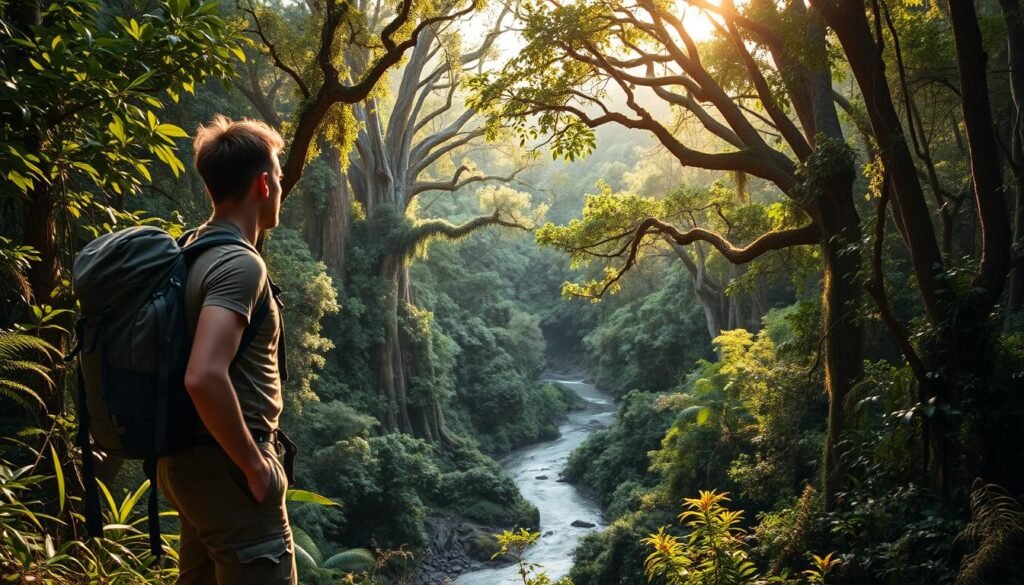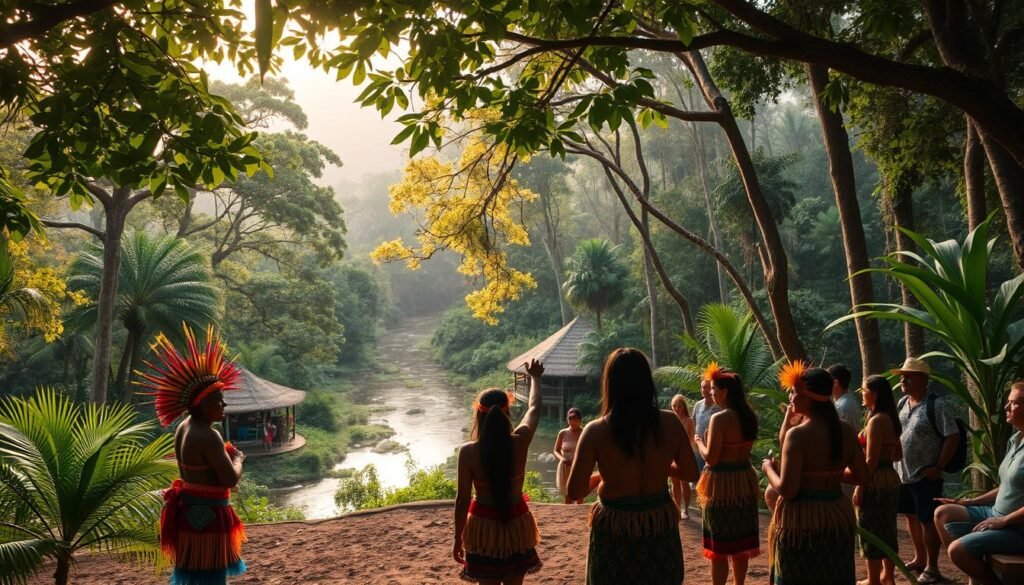Imagine standing in the world’s most vibrant ecosystem, surrounded by the Amazon‘s lush canopy. The air buzzes with exotic birds and animals. The scent of flowers fills your senses. This is what eco-conscious adventure feels like.
A trip here is full of adventure. You can explore through cultural exchange, photography, or spotting wildlife. The Amazon, the world’s largest rainforest, spans 1.4 billion acres. It offers a unique blend of exploration and caring for the environment.
By choosing eco-conscious adventure in this amazing place, you help protect the ecosystem. You also make memories that last a lifetime.
Key Takeaways
- Experience the world’s most diverse ecosystem in the Amazon Rainforest.
- Engage in various adventure activities, from cultural exchange to wildlife spotting.
- Contribute to environmental preservation through eco-conscious travel.
- Explore the largest rainforest, covering 1.4 billion acres.
- Create lasting memories in an unforgettable setting.
What Is Ecotourism in the Amazon Rainforest?
The Amazon Rainforest is perfect for ecotourism because of its amazing biodiversity. It’s not just about seeing nature; it’s also about helping the local environment and people. This kind of tourism supports sustainable travel and helps the area thrive.
Definition and Key Principles
Ecotourism means responsible tourism that keeps the environment safe and helps local people. It’s about not harming nature, respecting local cultures, and helping conservation. In the Amazon, ecotourism aims to:
- Save the rainforest’s rich wildlife
- Bring visitors and locals together
- Help local economies grow in a green way
Importance of Sustainable Travel
Sustainable travel is key in the Amazon Rainforest. The ecosystem is very sensitive and can be harmed easily. Travelers can help by using green practices, like:
- Picking eco-friendly tour operators
- Being careful with wildlife and their homes
- Backing local businesses and people
By choosing responsible tourism, visitors can help save the Amazon for the future. As more people want to see the Amazon, it’s vital to focus on being green. This way, tourism can help the environment and local communities.
The Biodiversity of the Amazon Rainforest
The Amazon Rainforest is one of the most diverse places on Earth. It’s home to many unique and threatened species. From the big jaguar to the tiny poison dart frog, life thrives here.
Unique Flora and Fauna
The rainforest boasts incredible plants like giant water lilies and towering kapok trees. It’s also home to thousands of bird species, including colorful macaws and hummingbirds. Mammals like sloths, monkeys, and tapirs add to the variety.
Reptiles and amphibians in the rainforest are just as fascinating. You’ll find anacondas, caimans, and poison dart frogs here. These animals are found nowhere else on Earth.
Endangered Species to Protect
Many Amazon Rainforest species face threats like habitat loss and poaching. It’s vital to protect these species and keep the ecosystem balanced.
Species like jaguars, giant otters, and Amazonian manatees are endangered. Governments, conservation groups, and local communities must work together to save them.
| Species | Status | Conservation Efforts |
|---|---|---|
| Jaguar | Near Threatened | Habitat protection, anti-poaching laws |
| Giant Otter | Endangered | Habitat preservation, research programs |
| Amazonian Manatee | Vulnerable | Protected areas, community engagement |
Supporting wildlife conservation tourism helps protect these species. It also supports local communities and encourages a love for nature.
Benefits of Ecotourism for Local Communities
The growth of eco-friendly tours in the Amazon Rainforest has helped local communities a lot. Nature-based tourism is now a big help to their economies. It also helps keep their cultural heritage alive.
Economic Advantages
Ecotourism brings in a lot of money to local communities. It creates jobs and boosts local economies. More tourists mean more demand for things like places to stay, food, and tours. This means more money for people who live there.
| Economic Benefits | Description | Impact |
|---|---|---|
| Job Creation | Local residents are employed as guides, hotel staff, and in other tourism-related jobs. | Reduces unemployment and increases household income. |
| Local Spending | Tourists spend money on local accommodations, food, and activities. | Stimulates local economies and supports small businesses. |
| Infrastructure Development | Investment in infrastructure to support tourism, such as roads and amenities. | Improves overall quality of life for local residents. |
Cultural Preservation
Ecotourism also helps keep local cultures alive. It supports local traditions and ways of life. By sharing their culture with tourists, communities can keep their heritage alive for the future.
When tourists and locals meet, they learn from each other. This exchange makes the tourists’ visit better. It also makes locals proud of their culture, helping them keep it alive.
Top Ecotourism Activities in the Amazon
The Amazon Rainforest is a paradise for ecotourists. It offers many activities for an immersive experience in a very biodiverse area. Visitors can try different adventures that are both exciting and educational, helping them understand the Amazon’s importance.
Guided Jungle Tours
Guided jungle tours are key in Amazon ecotourism. They let travelers explore the dense rainforest with guides who know a lot. These tours focus on biodiversity exploration, showing off the unique plants and animals of the Amazon.
Guides teach about the healing plants, the habits of exotic animals, and the complex ecosystem of the rainforest. Visitors might see monkeys, sloths, and many bird species. The guides’ knowledge makes the experience even more special, showing the beauty of the Amazon.
Birdwatching Opportunities
The Amazon Rainforest is famous for its birdwatching opportunities, with over 1,500 bird species. Birdwatchers can join tours to see rare and colorful birds. Seeing birds like macaws and toucans in the Amazon is a memorable experience.
- Spot exotic bird species in their natural habitat.
- Learn about the unique characteristics and behaviors of Amazonian birds.
- Enjoy the serene beauty of the rainforest while on a guided birdwatching tour.
Canoeing Adventures
Canoeing through the Amazon’s waterways is a peaceful and exciting way to see the rainforest. Paddling through rivers and streams, visitors can see wildlife that’s hard to spot on land. Canoeing lets you connect with nature in a unique way.
While canoeing, look out for caimans, dolphins, and many birds. The calm of canoeing in the Amazon offers a special view of the rainforest’s vast ecosystem.
Activities like guided jungle tours, birdwatching, and canoeing in the Amazon Rainforest are thrilling and help conservation. By participating in these activities, visitors help protect this amazing ecosystem for the future.
How to Choose an Ecotourism Operator
Finding the right ecotourism operator is key to a great experience. With many Amazon Rainforest tour options, it’s important to pick one that cares about the environment and local people.
Researching Responsible Companies
Start by looking for companies that really care about responsible tourism. They should support conservation, respect local cultures, and reduce their impact on the environment. Reading online reviews and talking to past travelers can help you understand their reputation.
Also, reach out to operators to ask about their sustainability efforts and how they help the local economy. A good operator will be open about their practices and share details with you.
Certifications and Accreditations
Looking for certifications is a smart way to check if an operator is serious about sustainable travel. The Global Sustainable Tourism Council (GSTC) and the International Ecotourism Society (TIES) give these certifications. They check if operators follow high standards for sustainability and responsible tourism.
These certifications mean the operator is doing things right. They focus on protecting the environment, respecting cultures, and working with communities. Choosing a certified operator means your trip will help the Amazon Rainforest and its people.
Preparing for Your Amazon Expedition
An Amazon expedition is an exciting journey. But, it needs careful planning to be both safe and fun. Travelers must consider several important factors for a successful trip.
What to Pack for Your Journey
Choosing the right gear is key for a comfortable Amazon trip. Lightweight, breathable clothes, sturdy boots, and waterproof items are must-haves. Also, bring a water purification system or filtered water bottles to cut down on plastic waste.
Don’t forget to pack eco-friendly items like biodegradable soap and toilet paper. This helps keep the Amazon clean. Make a detailed list with your tour operator to ensure you have everything you need.
| Item | Description | Eco-Friendly Alternative |
|---|---|---|
| Water Bottles | Single-use plastic bottles | Reusable water bottles with filters |
| Toiletries | Chemical-based toiletries | Biodegradable soap and toilet paper |
| Clothing | Synthetic fabrics | Clothing made from natural, sustainable materials |

Health and Safety Considerations
Health and safety are top priorities in the Amazon. Check with your doctor about needed vaccinations and malaria meds. Be aware of insect-borne diseases and use repellent and protective clothes.
Travel insurance that covers medical evacuations is highly recommended. Also, prepare physically by training and staying hydrated.
With proper preparation, your Amazon trip will be safe, fun, and eco-friendly. It will also support the local community and help protect this vital ecosystem.
Environmental Impact of Ecotourism
As ecotourism grows in the Amazon, balancing tourism with environmental conservation is key. Ecotourism can have both good and bad effects on the environment. It’s important to understand these impacts to support sustainable tourism practices.
Promoting Conservation Efforts
Ecotourism can be a strong tool for conservation. It supports protected areas and highlights the value of natural habitats. This helps protect biodiversity. Here are some ways ecotourism promotes conservation:
- Supporting conservation projects through tourism revenue
- Raising awareness about the importance of preserving natural habitats
- Encouraging sustainable practices among local communities
Also, wildlife conservation tourism is key in protecting endangered species and their habitats. By visiting protected areas, tourists support conservation efforts and enjoy nature’s beauty.
Reducing Carbon Footprint
While ecotourism promotes conservation, its carbon footprint is also a concern. The travel industry, including ecotourism, contributes to greenhouse gas emissions. To lessen this, tour operators and travelers can take steps:
- Opt for carbon offsetting programs to compensate for emissions
- Choose transportation methods with lower carbon emissions, such as electric or hybrid vehicles
- Reduce energy consumption at accommodations and during activities
By adopting these practices, ecotourism can become more sustainable and environmentally friendly. This ensures the Amazon Rainforest stays vibrant for future generations.
Cultural Experiences in the Amazon
Visiting the Amazon Rainforest through ecotourism lets you connect with indigenous communities. You learn about their traditions and ways of life. This promotes understanding and respect between cultures.
Meeting the Amazon’s indigenous people is a special experience. They have lived in the forest for centuries. They know the forest and its secrets well.
Engaging with Indigenous Communities
Talking to indigenous communities is deeply moving. You can join in on their ceremonies and learn about plants used for medicine. For instance, the Ticuna tribe welcomes visitors to share their culture and traditions.
“The forest is our pharmacy, our supermarket, and our cathedral. It’s where we find our identity and our spirituality.” – Davi Kopenawa, Yanomami shaman
These interactions are good for both the traveler and the community. They help the community financially and preserve their culture.
Learning Traditional Practices
Learning from indigenous communities is a key part of Amazon ecotourism. You can learn to make traditional crafts, hunt, and gather. These skills show the Amazonians’ resourcefulness and creativity.
| Traditional Practice | Description | Community |
|---|---|---|
| Medicinal Plant Use | Learning about the medicinal properties of various plants | Ticuna |
| Traditional Hunting | Understanding hunting techniques passed down through generations | Yanomami |
| Handicraft Making | Crafting traditional items like baskets and jewelry | Asháninka |
By taking part in these activities, you appreciate the Amazon’s cultural heritage more. You also help in preserving it.

In summary, the Amazon offers a rich cultural experience. It lets you connect with indigenous communities and learn from them. Responsible tourism ensures these cultural exchanges continue to benefit everyone involved.
What to Expect on Your Ecotourism Journey
Going on an ecotourism journey in the Amazon Rainforest is an unforgettable adventure. It lets you dive into nature’s beauty. As you enter this vibrant world, you’ll see lush greenery and hear the rainforest’s sounds. It’s the start of an eco-conscious adventure.
Immersive Nature Experiences
The Amazon Rainforest is full of life, with thousands of species waiting to be found. Guides, who know the forest well, will show you unique plants and animals. They’ll also tell you about the forest’s balance.
“The Amazon is not just a destination; it’s an experience that touches your soul,” many travelers say.
Daily Activities and Itineraries
Your daily activities will vary, but they’re all exciting. You might go hiking, canoeing, or learn from local communities. These activities help you understand and appreciate the Amazon’s nature and culture.
Your trip might include visits to remote villages. There, you can learn about traditional ways of life and why conservation is key.
While exploring, you’ll see wildlife like colorful macaws and majestic jaguars. It’s not just about watching animals. It’s about learning how everything in the ecosystem works together and why we need to protect it.
Your guides will make sure you don’t harm the environment. They follow Leave No Trace principles and support sustainable tourism. This way, your trip not only enriches your experience but also helps protect the Amazon for the future.
Tips for Being a Responsible Ecotourist
When you start your Amazon ecotourism journey, it’s key to travel responsibly. This helps keep the rainforest’s delicate ecosystem safe. By doing so, you make your trip better and help protect this special place.
Practicing Leave No Trace
Leave No Trace is a big part of being a responsible traveler. It means not leaving a mark on the environment. This includes throwing away trash right, not disturbing animals, and staying on paths.
By following these steps, you help keep the Amazon Rainforest beautiful and intact.
Supporting Local Economies
Supporting local businesses and communities is also important. Choose tours and places to stay that are owned by locals. This helps the local economy grow and supports conservation efforts.
By choosing eco-friendly options, you help protect the Amazon Rainforest for the future. Your actions really make a difference in saving this amazing place.

















Leave a Reply